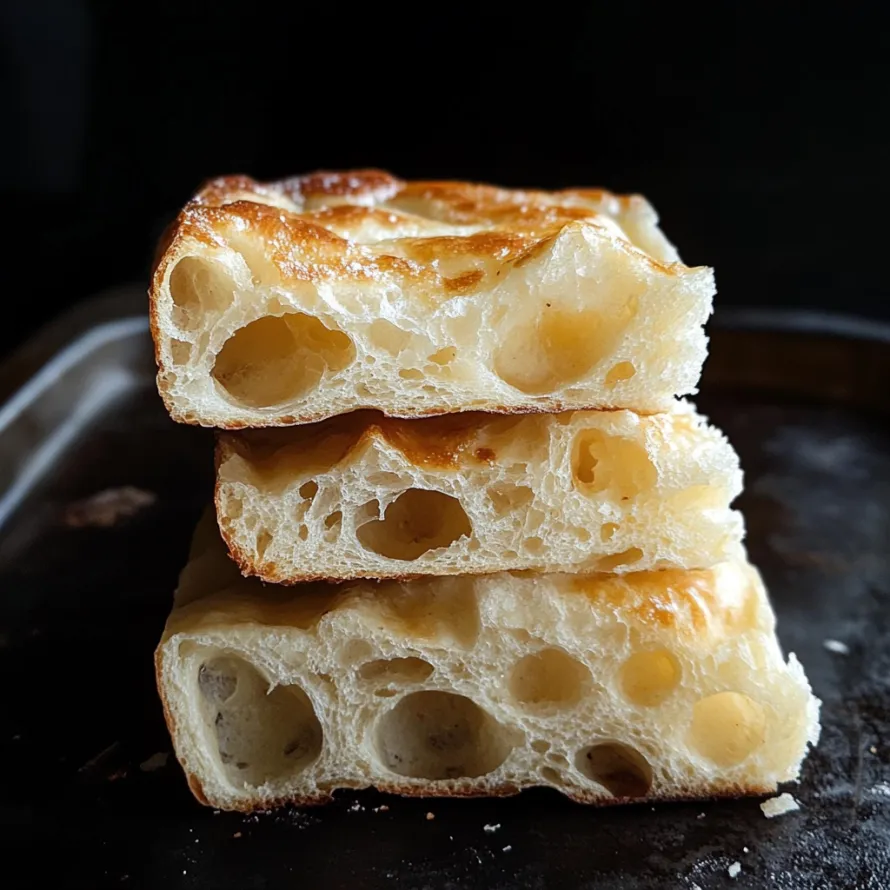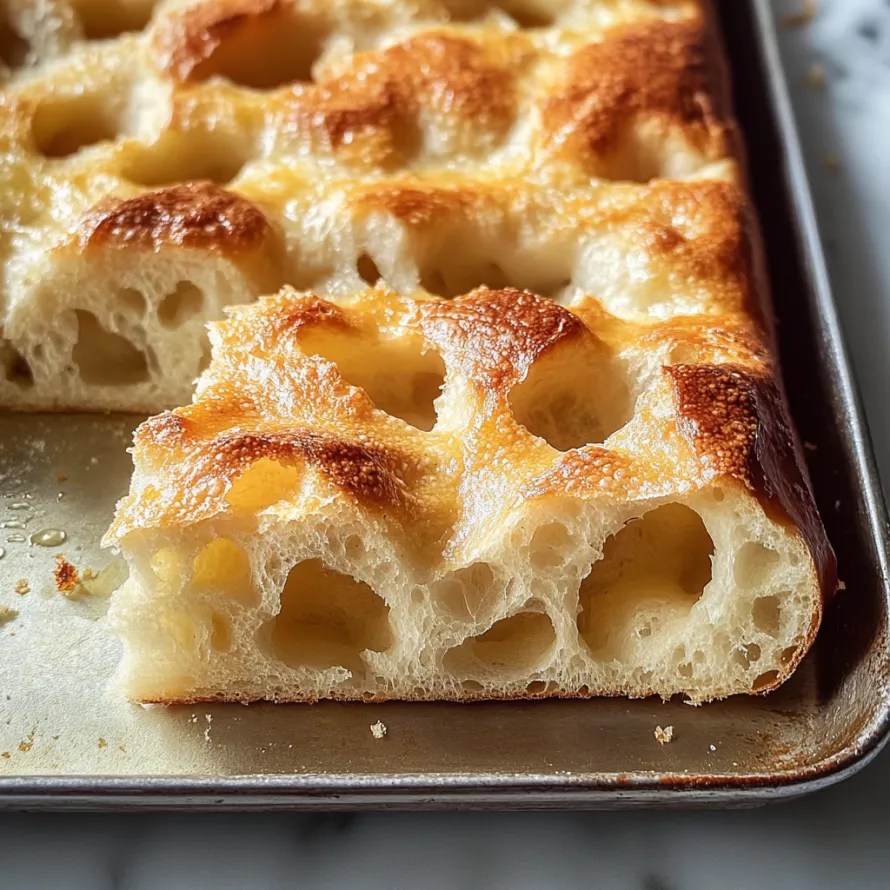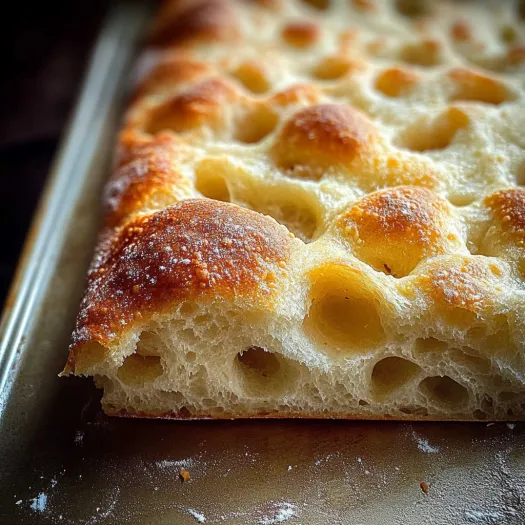 Save
Save
This fluffy sourdough focaccia turns everyday items into an amazingly soft bread with a delightfully crunchy base. The extended ferment builds deep flavor notes and that distinctive sourdough zip, while plenty of olive oil creates a lush, soft interior that goes well with just about any dish.
I came up with this bread one weekend when I couldn't stop thinking about the amazing focaccia I ate in Italy. After trying it several different ways, this version became my go-to bread that everyone now asks for whenever they come over.
What You'll Need
- 125 grams ripe sourdough starter: This is your magic ingredient that brings complex taste and natural rising power
- 375 grams water: Gives you that ideal moisture level for big, beautiful air pockets
- 10 grams sugar: Wakes up your starter and helps the crust brown nicely
- 500 grams bread flour: Delivers that wonderful chew factor; grab one with 11-13% protein content for best results
- 15 grams olive oil: Adds flavor throughout your dough; don't skimp on quality here
- 10 grams salt: Brings out all the tastes and helps manage the fermentation
- 1/4 cup olive oil: For the top; grab your nicest bottle for this finishing touch
- 1 teaspoon flaky salt: Creates yummy little flavor bursts across the surface
- Fresh or dried rosemary: Brings a wonderful earthy smell; fresh works best for stronger flavor
Making Your Focaccia
- Combine Starter and Dry Stuff:
- Mix your ripe sourdough starter with water, sugar, and bread flour until you get a rough, slightly messy dough. Don't worry about making it perfect—just make sure all the flour gets wet. Cover your bowl with a damp towel or plastic and let it sit somewhere warm for exactly one hour so the gluten can start developing naturally.
- Work in Salt and Oil:
- After your dough has rested, add the salt and olive oil. Adding these later keeps the salt from slowing down the initial rise. Really work them in with your fingers, pinching and folding the dough. At first, the oil will seem to slide off, but keep going and the dough will soak it all up.
- Let It Rise and Fold:
- Put your dough in a clean, oiled container with a lid. Let it puff up for about 90 minutes in a warm spot, around 75°F is perfect. Every half hour, grab each edge of the dough, stretch it up and fold it back over the middle, turning your container after each fold until you've done all four sides. This builds strength without working the dough too hard. Try to shape it roughly square to match your baking pan.
- Second Rise:
- Move your dough to a well-oiled baking sheet or parchment-lined pan. Let it spread out on its own and rise for another 3-4 hours until it's puffy and bubbly. The dough should look lively—almost like it's breathing. If your kitchen is cold, this might take longer. You can also stick it in the fridge overnight at this point for extra flavor, and bake it tomorrow or even a few days later.
- Get Ready to Bake:
- Heat your oven to 450°F with a baking stone inside if you have one. Right before baking, make those classic focaccia dimples by pushing your fingertips all the way down through the dough in many spots. Don't be shy—press hard all the way to the bottom of the pan. These dents will hold your olive oil and create that special focaccia look.

This focaccia turned into a weekly must-have at my house after I found out how nicely the dough waits in the fridge. I really love how the olive oil makes those crunchy edges that go so well with the soft middle. My favorite thing about this bread was when my kid said it was better than restaurant bread and then ate half the pan by herself.
Prep Ahead Tips
This dough gets even better when you use the fridge trick. You can make the dough through the first rise, then stick it in the refrigerator for up to three days before baking. This long, cold rest creates amazing flavor while working around your schedule. The dough actually gets tastier the longer it sits in the fridge.
Mix Up Your Toppings
Though rosemary and salt make a classic combo, focaccia works great with tons of different toppings. Try thin tomato slices and oregano in summer or sweet cooked onions and thyme anytime. For something different, push grapes into the dough before baking and sprinkle with sugar for an Italian-style grape bread treat.
Ways to Enjoy It
Focaccia works both as a snack on its own and alongside your meals. Serve warm chunks with a dish of good olive oil mixed with balsamic for dipping. It makes fantastic sandwiches when you cut it through the middle horizontally.

This focaccia is a surefire way to wow your friends or treat yourself. Its straightforward approach and incredibly rich flavors will have you making it over and over again.
Common Recipe Questions
- → Can I let the dough rise in the fridge overnight instead of a 3–4 hour rise?
Definitely! You can store the dough in the fridge for up to 2-3 days. Just make sure to loosely cover it with oiled plastic wrap. Baking it straight from the cold state often boosts the flavor.
- → Why do you dimple the focaccia before baking?
Dimpling does a bunch of things: it helps make that iconic texture, stops it from puffing up too much, and creates spaces for olive oil and toppings to seep into the dough and flavor it better.
- → How can I make the bottom of my focaccia crispier?
For extra crunch underneath, preheat a baking stone or steel. If you don’t have those, bake it near the oven's lower rack. Be sure to oil or line your pan well to prevent sticking.
- → Can other toppings work besides rosemary?
Of course! While rosemary is traditional, you’ve got plenty of options. Test it out with cherry tomatoes, olives, caramelized onions, thinly sliced potatoes, garlic, or other herbs like thyme or oregano.
- → What’s the goal of the stretch-and-fold method?
Stretching and folding strengthens gluten without overworking the dough, leaving it light and open. It distributes ingredients evenly and keeps air bubbles intact for that signature focaccia texture.
- → How do I know when the focaccia is done baking?
Perfectly baked focaccia is golden on top and crisp on the bottom. It’ll sound hollow if you tap it, and the inside temperature should hit about 200°F (93°C) if using a thermometer.
